
History of Geo- and Space Sciences
Scope & Guideline
Illuminating the evolution of Earth and planetary science.
Introduction
Aims and Scopes
- Historical Analysis of Scientific Discoveries:
The journal delves into the historical context of significant scientific discoveries in geophysics and space sciences, exploring how these advancements were achieved and their impact on modern science. - Preservation of Scientific Heritage:
It aims to document and preserve the legacies of key figures, institutions, and observatories in the fields of geophysics and space science, ensuring that their contributions are recognized and understood within the broader scientific community. - Interdisciplinary Approaches:
The scope includes interdisciplinary research that connects history with other fields such as meteorology, geology, and atmospheric sciences, highlighting how historical practices influence current scientific methodologies. - Exploratory and Observational Studies:
The journal features studies based on historical observations and data, such as meteorological records and auroral photography, contributing to a better understanding of past scientific practices and their relevance today. - Cultural and Social Contexts of Science:
It also explores the cultural and social factors that have influenced the development of scientific disciplines, including the roles of gender, societal views, and international collaborations.
Trending and Emerging
- Space Exploration Narratives:
There is an increasing focus on personal narratives and historical accounts related to space exploration, emphasizing the human aspect of scientific endeavors and their societal impacts. - Interdisciplinary Historical Studies:
Emerging themes include interdisciplinary studies that connect historical narratives with modern scientific practices, indicating a trend towards a more integrative approach to understanding the evolution of scientific thought. - Cultural Perspectives on Science:
A growing interest in the cultural and social dimensions of scientific practice is evident, with research exploring how cultural contexts shape scientific inquiry and public perception of science. - Historical Data Utilization in Current Research:
The utilization of historical data for contemporary research applications is gaining prominence, suggesting an increasing recognition of the value of past scientific observations in informing present-day scientific challenges.
Declining or Waning
- Traditional Geophysical Instrumentation:
There has been a noticeable decrease in articles focusing on the history and development of traditional geophysical instruments, suggesting a shift towards more contemporary methodologies and technologies in the field. - Classical Meteorological Studies:
Studies centered around classical meteorological observations and networks, such as early weather stations, are appearing less frequently, possibly due to a focus on more advanced and integrated climate science methodologies. - Historical Biographies of Lesser-Known Scientists:
While biographies of prominent figures remain relevant, there is a decline in the publication of works focused on lesser-known scientists, indicating a potential shift towards more recognized contributors in the field. - Localized Historical Case Studies:
Research articles concentrating on localized or singular historical case studies seem to be waning, with a growing preference for broader, more comparative analyses that connect various historical developments.
Similar Journals
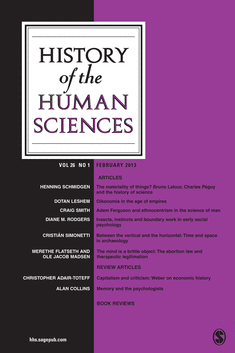
HISTORY OF THE HUMAN SCIENCES
Fostering Critical Dialogue in the Human SciencesHISTORY OF THE HUMAN SCIENCES is a prestigious journal published by SAGE PUBLICATIONS LTD, dedicated to advancing the field of human sciences through multidisciplinary scholarship. With an ISSN of 0952-6951 and an E-ISSN of 1461-720X, this journal has been a cornerstone of research since its inception in 1988 and continues to address significant themes in history and philosophy of science. The journal boasts an impressive Q1 ranking in both History and History and Philosophy of Science categories as of 2023, underlining its impact and relevance in the academic community. Although not an open-access journal, it provides a wealth of scholarly articles that encourage critical dialogue and foster innovative thinking among researchers, professionals, and students alike. Located in the United Kingdom, the journal is committed to exploring the complexities of human experience and knowledge across varied contexts, making it an essential resource for anyone dedicated to understanding the historical dimensions of science and its philosophical implications.
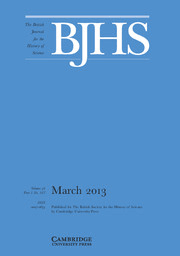
BRITISH JOURNAL FOR THE HISTORY OF SCIENCE
Engaging scholars in the rich narrative of scientific progress.The British Journal for the History of Science is a premier academic publication dedicated to exploring the intricate relationship between science and society throughout history. Published by Cambridge University Press, this journal features a rich blend of original research articles, critical reviews, and scholarly discussions that illuminate the development of scientific ideas and practices from antiquity to the modern era. With a strong reputation reflected in its Q1 classification in History and Q2 in History and Philosophy of Science for 2023, this journal plays an essential role in advancing the field by engaging researchers, professionals, and students alike. The journal's commitment to intellectual rigor and cross-disciplinary dialogue fosters a deeper understanding of how scientific thought has shaped our world. Although it does not offer open access, the journal maintains a strong academic footprint, making significant contributions to historical scholarship. Join a community of scholars who are passionate about unfolding the rich tapestry of scientific history, as the British Journal for the History of Science continues to publish cutting-edge research until 2024.

JOURNAL OF THE HISTORY OF BIOLOGY
Advancing Understanding of Biology’s Philosophical JourneyJOURNAL OF THE HISTORY OF BIOLOGY, published by Springer, stands as a vital academic resource devoted to examining the historical development of biological science and its philosophical dimensions. This esteemed journal, which has been in continuous publication since 1968 and encompasses research through 2024, is recognized for its significant contributions to the fields of Agricultural and Biological Sciences, and the History and Philosophy of Science, proudly holding a Q2 ranking in both categories as of 2023. With an ISSN of 0022-5010 and an E-ISSN of 1573-0387, it serves a diverse audience of researchers, professionals, and students interested in the interplay between biological advancements and historical context. The journal’s particular emphasis on interdisciplinary investigation provides a platform for innovative scholarship that enriches our understanding of not only the science itself but also its societal implications. While it does not currently offer open access, the rigor and reputation of the journal underscore its importance as a leading publication in the academic landscape of biological history.

HISTORY AND PHILOSOPHY OF THE LIFE SCIENCES
Connecting Historical Contexts with Philosophical Inquiry in Life SciencesHISTORY AND PHILOSOPHY OF THE LIFE SCIENCES, published by SPRINGER INT PUBL AG, stands as a leading peer-reviewed journal dedicated to exploring the intricate relationships between historical narratives and philosophical frameworks in the life sciences. With its robust impact factor and recognized position as a Q1 journal in key categories such as Arts and Humanities, History, and History and Philosophy of Science, this journal provides a vital platform for researchers, professionals, and students seeking to delve into the theoretical underpinnings and historical trajectories shaping contemporary life sciences. Established in 1979 and evolving through its converged years until 2024, it reflects the journal's enduring commitment to advancing scholarly discourse in its field. While the journal is not open access, it nonetheless attracts a diverse readership, facilitating meaningful research exchanges and interdisciplinary dialogues. Located in the picturesque country of Switzerland, the journal invites contributions that foster critical examination and innovative thinking in the historiography and philosophy of life sciences, ultimately enhancing our understanding of this dynamic and significant discipline.

ARCHIVE FOR HISTORY OF EXACT SCIENCES
Exploring the Intersections of Mathematics and HistoryARCHIVE FOR HISTORY OF EXACT SCIENCES, published by Springer, is an esteemed journal committed to promoting the understanding of the historical and philosophical dimensions of exact sciences, including mathematics and its application to various scientific fields. With a heritage dating back to 1964, this journal not only maintains a robust academic reputation in Germany but also reaches an international readership, reflected in its Scopus rankings, where it holds a commendable position in the 71st percentile for History and Philosophy of Science. The journal presently falls within Q3 and Q4 quartiles for its respective categories in 2023, highlighting its ongoing relevance and contribution to academia. As researchers, professionals, and students seek to explore the intricate relationships between mathematics, philosophy, and history, ARCHIVE FOR HISTORY OF EXACT SCIENCES serves as a key resource, fostering interdisciplinary dialogue and stimulating new inquiries in the complex landscape of science.
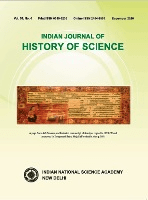
INDIAN JOURNAL OF HISTORY OF SCIENCE
Exploring the Rich Tapestry of India's Scientific LegacyINDIAN JOURNAL OF HISTORY OF SCIENCE, published by the Indian National Science Academy, offers a vital platform for researchers, professionals, and students dedicated to the exploration of the historical development of science and technology in India and beyond. With the ISSN 0019-5235 and E-ISSN 2454-9991, this peer-reviewed journal aims to promote interdisciplinary collaboration by publishing original research articles, reviews, and discussion papers that highlight the contributions and evolution of scientific thought throughout history. The journal fosters a unique understanding of how historical contexts have shaped current scientific paradigms, making it an essential resource for academic inquiry. Although it does not currently offer Open Access options, the journal's rigorous editorial standards ensure that it maintains a significant impact within the scholarly community, serving as a crucial reference point for historical scholarship in the sciences. Its address in Bahadur Shah Zafar Marg, New Delhi 110 002, India, situates it within a rich tapestry of cultural and academic heritage, further enhancing its significance in the field.
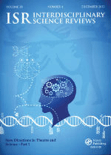
INTERDISCIPLINARY SCIENCE REVIEWS
Pioneering Research at the Intersection of Fields.INTERDISCIPLINARY SCIENCE REVIEWS, published by SAGE Publications Inc, is a prominent journal that serves as a pivotal platform for the convergence of insights across various domains, including the history and philosophy of science, interdisciplinary studies, and social sciences. Established in 1976 and continuing its legacy through 2024, this esteemed journal actively promotes innovative research and critical discussions, earning it a commendable Q2 ranking in key categories such as History and Philosophy of Science and Multidisciplinary, reflecting its influential contributions within the academic community. With a solid impact factor that highlights its relevance, INTERDISCIPLINARY SCIENCE REVIEWS is dedicated to fostering access to cutting-edge scholarship, although it currently does not offer open access options. The journal’s noteworthy rankings in Scopus further affirm its standing, making it an essential resource for researchers, professionals, and students seeking to explore interdisciplinary approaches to complex scientific inquiries.

Journal for General Philosophy of Science
Shaping the Future of Philosophical Discourse in ScienceJournal for General Philosophy of Science, published by Springer, stands as a pivotal resource in the fields of History and Philosophy of Science, as well as general Philosophy. With an impressive Q1 ranking in its categories and a solid reputation reflected in its Scopus rankings, this journal provides a robust platform for scholarly discourse and advancement in philosophical inquiry regarding science. The journal's commitment to quality is evident, catering to researchers, professionals, and students interested in the critical examination of scientific methods, theories, and their implications. While it operates on a subscription basis, the journal is dedicated to fostering a deeper understanding of philosophical issues surrounding scientific practices from 1980 through 2024. Operating out of the picturesque Netherlands, specifically from VAN GODEWIJCKSTRAAT 30, 3311 GZ DORDRECHT, the journal continues to encourage innovative thinking and interdisciplinary dialogue, underscoring its significance in academia today.
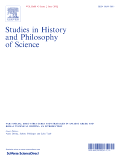
STUDIES IN HISTORY AND PHILOSOPHY OF SCIENCE
Illuminating the Historical Contexts that Shape ScienceSTUDIES IN HISTORY AND PHILOSOPHY OF SCIENCE, published by Elsevier Science Ltd, is a leading academic journal dedicated to the exploration of historical and philosophical dimensions of science. With both an ISSN of 0039-3681 and E-ISSN of 1879-2510, this esteemed journal has established itself as a pivotal resource since its inception in 1970 and continues to publish cutting-edge research reflecting the evolution of scientific thought. Situated in the United Kingdom, it is recognized for its high-impact contributions, boasting a Q1 ranking in both History and History and Philosophy of Science categories as of 2023. Researchers in the humanities will benefit from the journal’s rigorous analysis and insightful discussions, as evidenced by its competitive Scopus rankings—placing it in the 96th and 83rd percentiles in their respective fields. Although not an open-access journal, it maintains a commitment to scholarly excellence, aiming to foster a deeper understanding of the interconnections between historical context and philosophical inquiry in the scientific domain, making it an invaluable resource for students, professionals, and researchers alike.
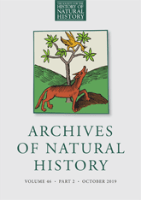
ARCHIVES OF NATURAL HISTORY
Celebrating the Rich Tapestry of Natural HeritageARCHIVES OF NATURAL HISTORY is a distinguished scholarly journal published by Edinburgh University Press, focusing on the interplay between history, anthropology, and the broader spectrum of natural sciences. With its ISSN 0260-9541 and E-ISSN 1755-6260, the journal serves as a vital resource for researchers and professionals in the fields of natural history and related disciplines. Encompassing a comprehensive range of topics from the history of nature to the evolution of environmental science, it has achieved a commendable impact factor and consistently ranks Q3 in both Agricultural and Biological Sciences and Anthropology, while significantly excelling with a Q1 rating in History as per the latest evaluations. The journal encompasses articles spanning from 1981 to 2024, enhancing its repository of knowledge with a historical depth seldom found in contemporary publications. Despite not being an open-access journal, it remains accessible to a global audience of scholars eager to explore nature's narratives and their historical significance. Engage with ARCHIVES OF NATURAL HISTORY to delve into a rich tapestry of interdisciplinary research that celebrates our planet's biological and cultural heritage.